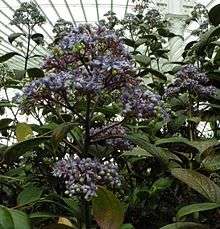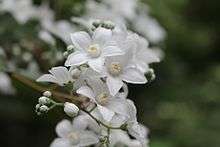Dichroa febrifuga
Dichroa febrifuga (Chinese: 常山; pinyin: ![]()
| Dichroa febrifuga | |
|---|---|
 | |
| Scientific classification | |
| Kingdom: | Plantae |
| Clade: | Tracheophytes |
| Clade: | Angiosperms |
| Clade: | Eudicots |
| Clade: | Asterids |
| Order: | Cornales |
| Family: | Hydrangeaceae |
| Genus: | Dichroa |
| Species: | D. febrifuga |
| Binomial name | |
| Dichroa febrifuga Lour.[1] | |

Traditional Chinese medicine
Dichroa febrifuga is an important herb in traditional Chinese medicine, where it is considered one of the 50 fundamental herbs.[2] The alkaloids febrifugine and isofebrifugine are believed to be responsible for its antimalarial effects.[3] In traditional preparations, it is used in conjunction with other plants such as Glycyrrhiza glabra (licorice), Ziziphus jujube and Zingiber officinale (ginger).[4]
References
- "Dichroa febrifuga". Germplasm Resources Information Network (GRIN). Agricultural Research Service (ARS), United States Department of Agriculture (USDA). Retrieved 2008-02-05.
- "Dichroa febrifuga - Plants For A Future database report". Retrieved 2008-02-05.
- Zhu, Shuren; Meng, Li; Zhang, Quan; Wei, Lai (2006). "Synthesis and evaluation of febrifugine analogues as potential antimalarial agents". Bioorganic & Medicinal Chemistry Letters. 16 (7): 1854–1858. doi:10.1016/j.bmcl.2006.01.009. PMC 2072810. PMID 16434194.
- Rasoanaivo, Philippe; Wright, Colin W; Willcox, Merlin L; Gilbert, Ben (2011). "Whole plant extracts versus single compounds for the treatment of malaria: Synergy and positive interactions". Malaria Journal. 10 (Suppl 1): S4. doi:10.1186/1475-2875-10-S1-S4. PMC 3059462. PMID 21411015.